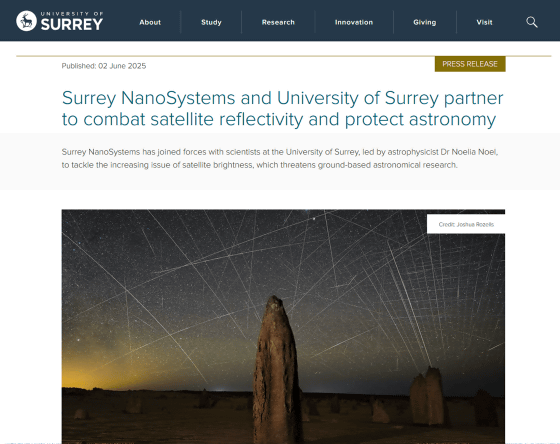An attempt is underway to protect astronomy by painting satellites with 'Vantablack,' which absorbs more than 99.9% of light, to prevent light pollution

With the advancement of space development technology and the spread of satellite internet, the number of artificial satellites orbiting the Earth is increasing rapidly. As a result, it has been pointed out that the reflected light from artificial satellites brightens the night sky, causing
Surrey NanoSystems and University of Surrey partner to combat satellite reflectivity and protect astronomy | University of Surrey
https://www.surrey.ac.uk/news/surrey-nanosystems-and-university-surrey-partner-combat-satellite-reflectivity-and-protect-astronomy

Satellite coated in ultra-dark 'Vantablack' paint will launch into space next year to help combat major issue | Live Science
https://www.livescience.com/space/space-exploration/satellite-coated-in-ultra-dark-vantablack-paint-will-launch-into-space-next-year-to-help-combat-major-issue
It is said that there will be approximately 11,700 operational satellites orbiting the Earth as of May 2025, and the number of satellites launched has increased dramatically since the 2010s. Experts estimate that the number of satellites orbiting low Earth orbit (LEO) will exceed 100,000 in the next 50 years.
However, it has been pointed out that the rapid increase in artificial satellites will cause various problems , such as 'space congestion and an increase in space debris,' 'environmental pollution due to greenhouse gas emissions from rocket launches and debris re-entering the Earth,' and so on.
One of the problems caused by satellites is light pollution, which is the brightening of the night sky due to reflected light. A 2021 study found that satellites could increase the overall brightness of the night sky by more than 10% above natural levels, raising concerns that this could have a significant negative impact on astronomy.
It turns out that 'light pollution' caused by artificial satellites is affecting astronomical observations around the world - GIGAZINE

So, Noelia Noel , an astrophysicist at the University of Surrey in the UK, and the team at Surrey NanoSystems, the developer of Vantablack, announced a plan to reduce the light pollution caused by satellites by painting them with a substance called 'Vantablack,' which absorbs most of the light. Surrey NanoSystems announced Vantablack, which was the blackest substance in the world at the time, in 2014 and caused a big stir.
The world's blackest material is born, transcending black, and the unevenness of the coated material is indistinguishable from the naked eye - GIGAZINE

For this mission, Surrey NanoSystems has developed a new coating called Vantablack 310 that can withstand the harsh LEO environment. The Vantablack 310 coating method will be tested on Jovian 1 , the first satellite mission of the JUPITER program, a collaborative university program for on-orbit training, education and research.
Jovian 1, scheduled for launch in 2026, is a shoebox-sized CubeSat that will be coated on one side with Vantablack 310. By observing the Jovian 1 spacecraft orbiting Earth, the team will be able to determine whether the dark coating works as expected and whether it can withstand the harsh conditions of space.
Dr Kieran Clifford, Senior Technologist and Project Leader, Surrey Nanosystems, said: 'Our latest coating technology, Vantablack 310, delivers ultra-black performance over a wide viewing angle whilst being robust to the harsh LEO environment. We are proud to be in partnership with the University of Surrey to drive innovation in satellite design and ensure sustainable and equitable access to the night sky for all.'

in Science, Posted by log1h_ik